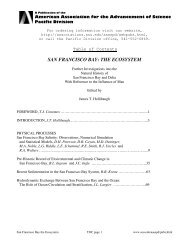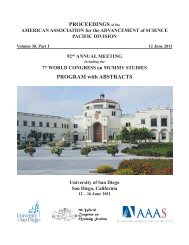Vol 31, Part I - forums.sou.edu ⢠Index page - Southern Oregon ...
Vol 31, Part I - forums.sou.edu ⢠Index page - Southern Oregon ...
Vol 31, Part I - forums.sou.edu ⢠Index page - Southern Oregon ...
Create successful ePaper yourself
Turn your PDF publications into a flip-book with our unique Google optimized e-Paper software.
ABSTRACTS – Contributed Papers/Posters<br />
Third, the biological/social explanation [Sigma Xi<br />
Forum, 2011] for why the Scientific Method developed quite<br />
exclusively in the Western/Christian world is due to its founding<br />
principle for day-to-day behaviour: Christ’s Golden Rule<br />
[Matthew 7:12; Luke 6:<strong>31</strong>].<br />
MATHEMATICS<br />
Continuing from Tuesday (refer to <strong>page</strong> 90 of these Proceedings).<br />
Wednesday, starting at 10:00 a.m. in PONDEROSA PINES 1 & 2<br />
150 Non-Hodgkin-Huxley Model of Cardiac Function,<br />
DAVID BLACKMAN (Retired University of California,<br />
Berkeley and Honorary Professor, Albert Schweitzer International<br />
University; current address: 307 W 2 nd St., Phoenix,<br />
OR. 97535-7733; gribear@mac.com).<br />
There are four theorems derived from first principles,<br />
which are descriptive of cardiac function. Each theorem<br />
has real-world consequences explaining: the connection<br />
between polarization and contraction, leakage current and<br />
T wave alternans, polarization by active transport, and the<br />
origins of the ECG signal. Each of these theorems has realworld<br />
consequences. Theorems 2 and 3 elucidate the origins<br />
of arrhythmia and a treatment for arrhythmia. Since<br />
Rosenbaum’s work, T-wave alternans are both a predictor of<br />
arrhythmia and the signposts to understanding arrhythmia.<br />
The most important consideration is the independence of<br />
active and passive transport of potassium ions. By exploiting<br />
this independence it is possible to get to the root of arrhythmia.<br />
This is an alternative theory to the Hodgkin-Huxley<br />
model for cellular transport. This model exploits the obvious<br />
in concert transport of all the passive channels and leads to a<br />
new mathematical construct called the Hamiltonian dynamic<br />
as an alternate explanation for cessation of passive transport.<br />
151 Experimentation at the Frontiers of Reality in Schubert<br />
Calculus, ZACH TEITLER (Department of Mathematics,<br />
Boise State University, 1910 University Drive, Boise, ID<br />
83725; zteitler@boisestate.<strong>edu</strong>).<br />
How many lines meet four given lines This is a question<br />
in Algebraic Geometry. It can be worked out by computers<br />
using Computational Algebra, including techniques such<br />
as Grobner bases. But in fact the answer was already known<br />
in the 19th century as one of the first examples of Schubert<br />
calculus. We can show (with pictures!) that the answer is<br />
two. Along the way we’ll get a brief overview of these fields<br />
of mathematics.<br />
But how many of those solutions are real, as opposed to<br />
complex This is the subject of the Shapiro conjecture, which<br />
says that in some conditions all the solutions are real. The<br />
conjecture has been proved in some settings; it remains open<br />
in other settings, and various generalizations are also open.<br />
An intergenerational team of faculty, postdocs, and graduate<br />
students has tested (and continues to test!) the conjecture<br />
using a supercomputing network of moonlighting computers.<br />
We have computed billions of examples using over a<br />
terahertz-year of computing power, giving overwhelming<br />
evidence for the conjecture and discovering new phenomena<br />
beyond the conjecture.<br />
152 Driving Hazards in 2-Spheres, JENS HARLANDER<br />
(Department of Mathematics, Boise State University, 1910<br />
University Drive, Boise, ID 83725; jensharlander@boisestate.<strong>edu</strong>).<br />
The the early 1990’s Anton Klyachko discovered what<br />
he termed a “funny property of the sphere”. If cars drive<br />
around the boundary of the regions in a tiling of the 2-sphere,<br />
clockwise, continuously and without stopping, then somewhere<br />
a total collision will occur. He used this observation to<br />
settle a major case of the Kervaire conjecture, stated in 1963.<br />
Klyachko’s observation, which he thought of as suitable for a<br />
high school competition, turned out to be the tool needed for<br />
making considerable advances in the _field of combinatorial<br />
topology and group theory. In my talk I will explain Anton<br />
Klyachko’s funny property of the sphere.<br />
contributed<br />
POSTERS<br />
PHYSICS and MATERIALS SCIENCE<br />
153 Pushing the Neutral Atom Microscope Past Conventional<br />
Optical Resolution, PHILIP WITHAM* and ERIK<br />
SÁNCHEZ (Department of Physics, Portland State<br />
University, P.O. Box 751, Portland, OR, 97207-0751; pjw@<br />
pdx.<strong>edu</strong>, esanchez@pdx.<strong>edu</strong>).<br />
Recent advances have made microscopy using a beam<br />
of neutrally charged gas particles a practical reality. This<br />
technique is also called Atomic DeBroglie Microscopy and<br />
Scanning Helium Microscopy. The particle energy used is<br />
under 0.07 eV, roughly 10 5 times lower energy than a typical<br />
SEM or Helium Ion microscope, resulting in a probe beam<br />
that scatters from the first atomic layer of samples, and<br />
with little chance of beam damage. Others working with<br />
molecular beam experiments have shown the potential for<br />
new science using neutral atom scattering. For these reasons,<br />
this form of microscopy has been pursued for twenty years<br />
by a number of researchers, with the first success published<br />
in 2008 by Koch, Rehbein, Schmahl, Reisinger, Bracco,<br />
Ernst, and Holst.<br />
At our lab we developed a Neutral Atom Microscope<br />
(NAM) which produced the first images ever obtained in<br />
reflection mode from gas scattering. This has been improved<br />
to the possibly record resolution of 0.35 µm. It has allowed one<br />
92








